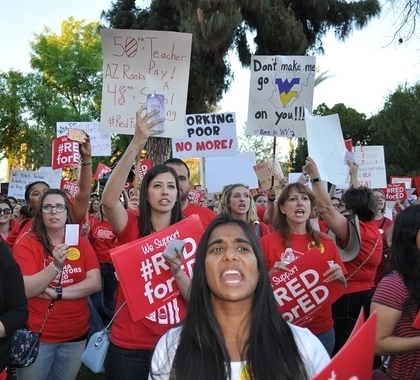Arizona teachers have finally returned to their classrooms after a six-day strike over salary increases. Even worse, the thousands of teachers across the state who chose not to go to work simply because they wanted more money had already been promised a pay raise. Apparently, these “public servants” didn’t think their cushy benefits, extensive vacation time, and guaranteed pay raises were enough to keep them in their classrooms.
As usual, the media portrayed the strike in a completely false manner. Stories were often written as though the strikes were part of a noble stand by selfless teachers against heartless Arizona Gov. Doug Ducey and his evil band of Republican lawmakers, who teachers unions said “slashed” education funding in a wicked ploy to harm students and teachers.
In reality, the strike was organized by Arizona Educators United (AEU) to increase teachers’ salaries, and thus increase dues and fees to the union’s coffers. AEU demanded an immediate 20 percent pay increase for teachers, even though Ducey had promised a 20 percent raise by 2020, but that wasn’t good enough for the greedy teachers unions.
Like all public employee unions, teacher unions have significant leverage, especially when they utter the word “strike.” Of course, nobody wants to see children unnecessarily removed from classrooms, so unions such as AEU wield their immense power by employing strikes as a heavy-handed negotiating tactic.
While Arizona teachers were away from the classroom demonstrating for more taxpayer money, they were also holding Arizona families hostage, forcing parents to miss work or fork over childcare expenses — and AEU’s members knew exactly how problematic and painful their strike was for families, too. For instance, AEU strike participant Kathleen Honne said, “One thing we can hold hostage, that really will impact a ton of people, is graduation!”
[Correction: Ms. Honne was initially misidentified as an assistant principal in the Dysart School District, a position she no longer holds. Her quote does not reflect the position of the district nor any official administrator.]
Aren’t educators supposed to support families, not harm them?
AEU and other teachers unions across the country have argued strikes are necessary to ensure educators receive the pay and benefits they deserve but aren’t receiving. But is this victimization of public school teachers reasonable? Was the fiscal situation in Arizona so dire teachers had no choice but to conduct a mass walkout?
Under Ducey’s proposed education funding plan, average teacher salaries would have increased by nearly $10,000, up to $58,130 by 2020, which means the average teacher in the Grand Canyon State was already scheduled to be paid about $2,000 more than the 2017 median household income in the United States. And Arizona teachers already receive special benefits most working families do not. For example, they work full-time only nine to 10 months each year, receive generous retirement benefits, and have access to excellent health care coverage — all courtesy of taxpayers.
In 2017, Arizona school districts spent a whopping $7.8 billion on K–12 education. Yet Arizona schools spent just 53.8 percent in the classroom, which is 6.9 percent points less than the national average. Besides buildings and maintenance, a large chuck of the non-classroom spending goes to fulfill numerous state and federal mandates, many of which do not improve educational quality. These are the real culprits preventing teachers from getting bigger raises and additional funds for classrooms.
Mathew Ladner, senior adviser for policy and research for the Foundation for Excellence in Education noted recently, “A class of 30 students produces over $300,000 in revenue. Even with benefit costs included, teacher compensation will not even sniff 20 percent of the revenue generated by this class of 30. Where did the rest of the money go?”
As Ladner later notes, the answer to his question is that non-teaching staff has increased by 138 percent and the number of teachers on staff has increased by 60 percent, even though student enrollment has grown only 8 percent. From these figures, it’s clear taxpayers’ money is being squandered by administrators and government agencies.
If Arizona teachers want higher salaries, they ought to demand the army of bureaucrats that occupy school district offices walk out — permanently.
[Originally Published at InsideSources]






